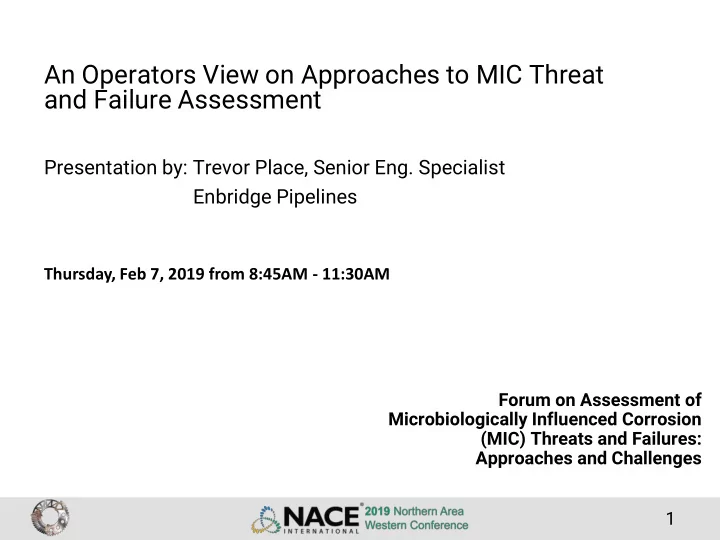

An Operators View on Approaches to MIC Threat and Failure Assessment Presentation by: Trevor Place, Senior Eng. Specialist Enbridge Pipelines Thursday, Feb 7, 2019 from 8:45AM - 11:30AM Forum on Assessment of Microbiologically Influenced Corrosion (MIC) Threats and Failures: Approaches and Challenges 1
Outline – MIC Assessment • Existence of Threat • Magnitude of Threat • Assessing MIC (RCA/diagnosis) • Discussion • Case Study 2
Existence • Existence of threat is informed by: • Sampling and testing Bacteria are (nearly) everywhere • Experience A small number of confirmed instances of MIC • Presumption Rapid corrosion with no other explanation • Industry knowledge Constantly being refined/improved 3
Magnitude • Magnitude of threat is informed by: • Monitoring ILI is principal tool for mainlines • Experience Rapid corrosion is (thankfully) rare • Monitoring Near real-time SCADA analysis of operations • Experience Customized flow models/surveillance • Monitoring Pig trash is analysed for microbial activity • Industry knowledge Constantly being refined/improved 4
Assessing MIC (diagnosis) • Presence of bacteria is not enough! • Three supporting legs for MIC determination: • There are higher populations of bacteria at the failure site than in the environment, or at other non-corroded areas • There are corrosion product or chemical species consistent with the type of microorganisms observed • The corrosion (rate) can not be explained by other causes • genoMIC provides unique opportunity for world class analysis 5
Case Study – 1 (2012) • Relief piping (~no flow) • 6.35mm w.t. • 19 years old • Relative low spot (utility underpass) • Lots of bacteria on bottom • Culture / microscopy • More APB at leak compared to all other locations • Dead leg, low spot, UDC • MIC considered ‘likely’ 6
Case Study – 2 (2017) • Manifold end (~no flow) • mm w.t. • years old • Enhanced investigation: • Careful sampling • Preservation/storage • Expediting to lab • Clear/simple instructions • (some luck) 7
Results Analysis of Field Samples Laboratory Cultures Location pH Iron Acetate XRD Sulphate Pitting (mM) (mM) consumption severity Leak site 6.92 343 17.26 FeCO 3 : 45-55% 3 mM/month Most severe Fe 9 S 8 : ND Fe: ND CaCO 3 : 1-8% Adjacent 6.95 57 20.59 FeCO 3 : 20-30% 2 mM/month Moderate location Fe 9 S 8 : ND Fe: 1-10% CaCO 3 : 25-35% Non- 6.67 12 2.42 FeCO 3 : ND 1 mM/month None corroded Fe 9 S 8 : 1-10% area Fe: ND CaCO 3 : 1-10% 8
Conclusions • Fermentative organisms producing organic acids figured prominently • Biofilm formers also present in large numbers • Organisms associated with EMIC were present (at lower numbers), and may have contributed to the corrosion at this site 9
Recommend
More recommend